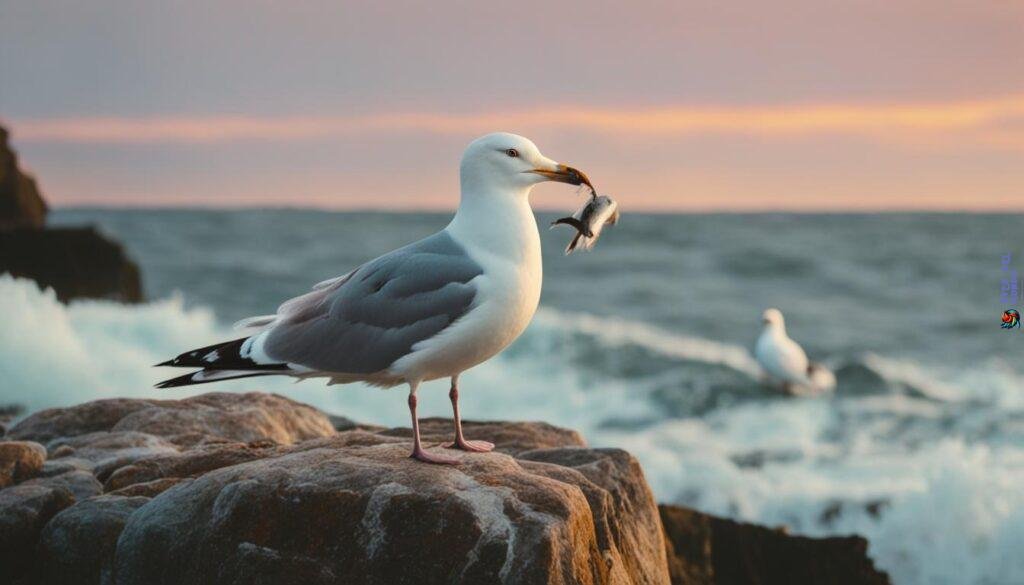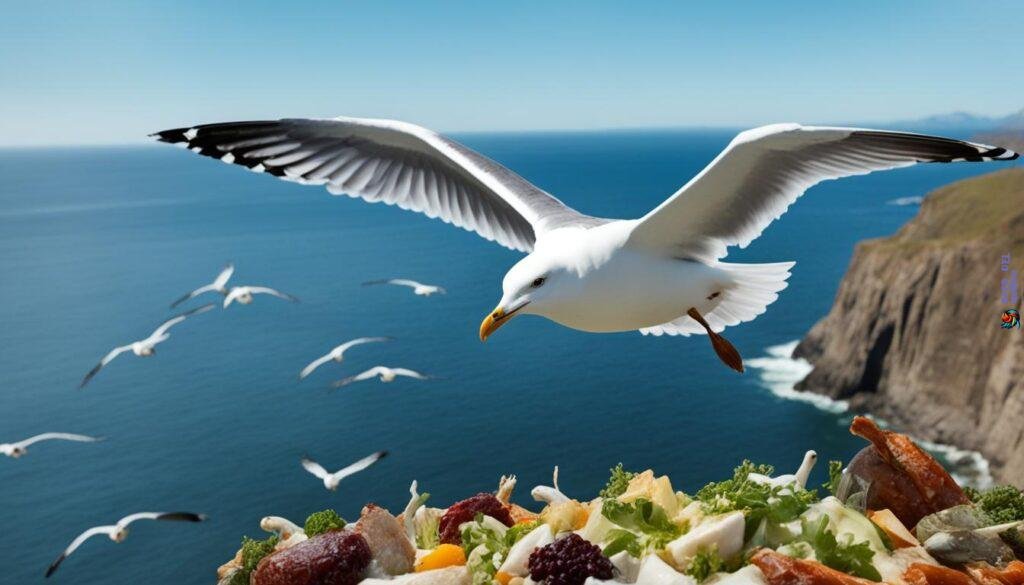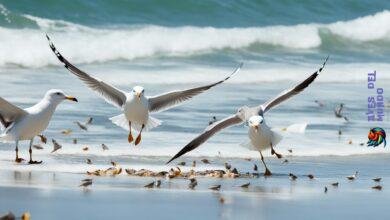Seagulls are fascinating birds that can be found in various habitats around the world. Their adaptability allows them to thrive in both coastal and inland areas, making them a common sight near bodies of water. Whether it’s the crashing waves of the ocean or the serene banks of a river, seagulls find their natural habitat in these diverse locations.
Seagulls are known for their versatile diet, as they are opportunistic scavengers and hunters. They have the ability to feed on a wide range of food sources, including fish, marine and freshwater invertebrates, rodents, insects, seeds, and even leftovers from human meals. This flexibility enables them to survive and flourish in different environments.
When it comes to nesting, seagulls exhibit interesting behaviors. They prefer to build their nests in secluded areas such as cliff faces and locations close to the water. These secluded nesting sites provide protection for their young and reduce the risk of predation. Seagulls are devoted parents, fiercely guarding their nests and territories against intruders.
Understanding seagull habitats, behavior, and feeding habits is crucial for appreciating these remarkable birds. In the following sections, we will dive deeper into the different facets of seagull life, including their diverse habitats, nesting habits, feeding behaviors, and unique adaptations for survival.
Seagull Habitat Diversity
Seagulls are known for their adaptability and can be found in diverse habitats around the world. They are not restricted to coastal areas and can be seen in various environments, including inland rivers and islands. Seagulls have the remarkable ability to thrive in different types of ecosystems, showcasing their versatility as a species.
Seagulls inhabit a wide range of coastal ecosystems, including coral reefs, mangroves, backwaters, lagoons, estuaries, and sand seagrass beds. These diverse habitats provide seagulls with ample opportunities to find food, mate, and raise their young. Their ability to adapt to different environments is one of the key factors that contribute to their success as a species.
Not only do seagulls thrive in natural habitats, but they have also become a common sight in urban areas. These adaptable birds have learned to scavenge for food in garbage cans and other urban environments, taking advantage of human presence to find sustenance. This ability to coexist with humans has allowed seagulls to expand their habitat range and thrive even in heavily populated areas.
Seagulls are social creatures and often form colonies that can range from a few pairs to thousands of birds. These colonies provide them with a sense of safety and opportunities for social interaction. During the winter months, seagulls may migrate to warmer climates in search of better food sources and nesting sites.
Seagulls in Coastal Ecosystems:
In their natural habitats, seagulls play important roles in coastal ecosystems. They contribute to the balance of marine and terrestrial food chains by feeding on fish, marine and freshwater invertebrates, and other small animals. Seagulls also help disperse seeds and nutrients, contributing to the overall health and diversity of coastal ecosystems.
Seagulls in Urban Areas:
In urban areas, seagulls fulfill a crucial ecological role by helping to manage waste. By scavenging for food scraps in cities, they contribute to the decomposition of organic waste and reduce the amount of garbage that ends up in landfills. However, it is important to note that human activities can also pose challenges to seagulls, such as pollution and habitat destruction. Ensuring responsible waste management and conservation practices is essential for maintaining a balance between human activities and seagull habitats.
Overall, the diverse habitat range of seagulls showcases their adaptability as a species. From coastal ecosystems to bustling cities, these birds have the ability to thrive in a variety of environments. Their presence in different habitats contributes to the ecological balance and serves as a reminder of the remarkable resilience and adaptability of nature.
Seagull Nesting Habits
Seagulls are known for their adaptive nesting habits, utilizing various locations to build their nests. They can be found nesting on the roofs of buildings, as well as on cliffs in more secluded areas close to the water. These nesting sites provide seagulls with the necessary protection against predators and allow them to live in large colonies.
Seagulls are monogamous birds, with each breeding couple occupying and protecting their own territory from neighboring couples. Their nests are often built close to one another, facilitating group living and providing additional protection for their young. This proximity allows them to defend against predators effectively.
If a predator dares to invade the seagull nesting area, the entire flock will unite and descend upon the intruder, demonstrating their collective defense mechanism. This behavior showcases the strong protective instincts of seagulls and ensures the safety of their offspring.
Seagulls prioritize nesting sites that are near the water or feature steep inclines on cliff faces. These locations offer both easy access to food sources, such as fish and invertebrates, and protection against ground-based predators.
To illustrate seagull nesting habits more comprehensively, a table is provided below showcasing different nesting sites commonly used by various seagull species:
| Seagull Species | Nesting Sites |
|---|---|
| Herring Gull | Cliffs, rocky outcrops, rooftops |
| Great Black-backed Gull | Islands, rocky shores, coastal marshes |
| Laughing Gull | Beaches, salt marshes, dunes |
| Kelp Gull | Rocky coasts, islands, harbors |
| Black-headed Gull | Wetlands, gravel rooftops, sandy beaches |
| Vega Gull | Coastal cliffs, tundra areas, riverbanks |
Seagull nesting habits vary based on the specific species and their geographic location. By adopting diverse nesting strategies, seagulls can successfully reproduce and raise their young in a wide range of environments.
Interesting Fact:
Seagulls often reuse their nests from previous breeding seasons, making minor repairs and additions to ensure their suitability for the upcoming eggs and chicks. This behavior showcases their resourcefulness and adaptability in utilizing available resources efficiently.
Understanding seagull nesting habits provides valuable insights into their behavior and helps us appreciate their ability to adapt and thrive in various environments. The intricate social structures and protective measures employed by seagulls highlight their resilience and their dedication to ensuring the survival of their offspring.
Seagull Feeding Habits
Seagulls are highly adaptable feeders and have a diverse diet that includes both plant and animal sources. They are primarily carnivorous, with a diet consisting of fish, marine and freshwater invertebrates, arthropods, and smaller birds. Seagulls are skilled hunters, targeting their prey with precision and agility.
Aside from their carnivorous habits, seagulls also consume a variety of other food sources. They are opportunistic feeders and will scavenge for eggs, carrion, and offal. Seagulls have even been observed eating reptiles, amphibians, fruit, and seeds. In urban areas, they are known to feed on leftovers from human meals and scavenge through garbage cans in search of food.
Seagulls display unique feeding behaviors, adapting their hunting techniques to the prey and resources available in their environment. For example, seagulls engage in dipping, where they quickly plunge their beaks into the water to catch fish, or foot paddling, where they walk along shallow waterways and kick their feet to flush out hidden prey. They are also adept at stealing food from other birds, animals, and even unsuspecting humans.
To crack open shellfish, such as clams and mussels, seagulls have developed a clever method involving shell-dropping, where they carry the shell high in the air and drop it onto rocks or hard surfaces to break it open. This ingenious adaptation grants them access to the nutritious contents inside.
Seagulls’ ability to adapt and find food sources in various environments contributes to their success as a species. Their hunting prowess and resourcefulness enable them to thrive in coastal ecosystems, urban areas, and even farmland.
Seagull Feeding Habits: A Summary
In summary, seagulls have a versatile and adaptable diet, allowing them to exploit a wide range of food sources. Their primary diet consists of fish and marine invertebrates, but they are also opportunistic scavengers, consuming eggs, carrion, offal, and even fruit and seeds. Seagulls utilize various hunting techniques to catch prey, such as dipping and foot paddling, and have developed specialized methods like shell-dropping to access hard-to-reach food sources. Their resourcefulness and ability to thrive in different environments showcase their remarkable feeding habits.
| Diet | Examples |
|---|---|
| Carnivorous | Fish, marine and freshwater invertebrates, arthropods, smaller birds |
| Scavenging | Eggs, carrion, offal |
| Additional Sources | Reptiles, amphibians, fruit, seeds |
| Unique Feeding Methods | Dipping, foot paddling, shell-dropping |
| Opportunistic Behavior | Stealing food from other birds, animals, and humans |
Seagull Adaptations for Feeding
Seagulls have evolved various adaptations to facilitate their feeding habits. These adaptations enable them to thrive in their natural habitats and take advantage of available food sources.
One notable adaptation is their unhinging jaws, which allow seagulls to consume large prey. This flexibility in their jaw structure enhances their ability to capture and swallow a wide range of food items.
The beaks of seagulls are another important adaptation for feeding. Their beaks are long, thick, and end with a hook, enabling them to grasp and manipulate different types of prey. This specialized beak shape and structure make it easier for seagulls to tear apart food and extract nourishment.
Webbed feet are yet another adaptation that aids seagulls in feeding. These webbed feet help them swim and walk on various surfaces, allowing them to access different food sources both in water and on land.
Seagulls possess broad wings that are essential for their feeding behavior. These wings enable them to fly effortlessly, navigate their environment, and cover large distances in search of food.
When it comes to catching prey, seagulls exhibit remarkable flight skills. They are capable of hovering in the air, plunging into the water, and dipping to catch prey. These agile flight maneuvers give them an advantage in capturing fast-moving or elusive food items.

Seagulls are opportunistic feeders and have a repertoire of feeding methods at their disposal. They can adjust their feeding strategies depending on the availability of prey and the specific conditions in their environment. This adaptability allows them to maximize their chances of securing a meal.
Feeding Methods
Here are some of the feeding methods observed in seagulls:
- Dipping: Seagulls plunge their beaks into the water to catch fish or other aquatic organisms.
- Foot Paddling: Seagulls rhythmically paddle their feet on the surface of the water, mimicking the movements of a swimming bird, to attract fish or dislodge prey from the sediment.
- Shell Dropping: Seagulls drop hard-shelled prey, such as clams or mussels, onto hard surfaces from a height to crack open the shells and access the meat inside.
- Scavenging: Seagulls are skilled scavengers and will opportunistically feed on leftovers from human meals, garbage, or other sources of easily accessible food.
Seagulls’ versatile adaptations for feeding, combined with their opportunistic behavior, enable them to thrive in a variety of habitats and maximize their chances of finding food.
Seagull Behavior Around Humans
Seagulls have adapted their behavior to live among humans, especially in heavily populated areas. These resourceful and intelligent birds do not typically demonstrate fear of humans or other animals, and they have learned to take advantage of the presence of humans in various ways.
Inquisitive and Opportunistic
Seagulls are known for their inquisitive nature, always exploring their environment for potential food sources. They have discovered that humans can be a reliable source of food, and they will take advantage of any opportunity to scavenge meals that are readily available.
They do not shy away from flying around parking lots, highways, and bridges, where they can find leftover food scraps and absorb the radiant heat from paved surfaces.
In urban areas, seagulls have become adept at scavenging through garbage cans and dumpsters, finding discarded food items that they can consume. Their ability to adapt their behavior to benefit from human presence has allowed them to thrive in areas where other bird species may struggle.
Highly Developed Social Structure
Seagulls have a complex social structure that allows them to interact and function within their colonies. They have a strong sense of community and demonstrate social behaviors that play a crucial role in their survival.
Seagulls may exhibit mobbing behavior when protecting their breeding colonies or when harassing predators and intruders.
In moments of danger, seagulls will unite as a collective group to defend their territory and their young. This mobbing behavior serves as a form of protection against potential threats, ensuring the safety of their offspring.
Intelligent and Curious
Seagulls are highly intelligent birds, capable of problem-solving and learning from their surroundings. They are known to use their cognitive abilities to navigate complex situations and adapt their behavior accordingly.
Their curiosity drives them to explore new environments and learn from their experiences. Seagulls can quickly identify patterns and make decisions based on prior knowledge, allowing them to navigate their interactions with humans and other animals successfully.
Living Among Humans
Seagulls have become a common sight in many seaside towns and cities around the world. Their ability to adapt their behavior to live harmoniously alongside humans is a testament to their resilience and versatility.
Summary
Seagulls have learned to coexist with humans by adapting their behavior to take advantage of the resources and opportunities provided by human presence. Their inquisitive nature, complex social structure, intelligence, and adaptability have contributed to their success in living among us.
Seagull Communication and Social Structure
Seagulls are highly social birds that rely on effective communication to establish and maintain their complex social structure. Through a rich repertoire of vocalizations and body movements, these intelligent birds convey important messages within their colonies.
Seagull colonies, known for their noisy and densely packed nesting sites, provide an ideal environment for social interactions. Breeding pairs of seagulls occupy and protect their territories, forming monogamous bonds. They share responsibilities such as incubating the eggs, feeding their chicks, and defending their nest against intruders.
Young seagulls form nursery flocks, where they engage in playful activities and learn essential life skills under the watchful supervision of adult males. These nursery flocks help develop social bonds and create a sense of community among the younger members of the colony.
Seagulls rely on communication to establish and maintain their complex social structure
Communication plays a crucial role in various social interactions among seagulls. Young seagulls, when hungry, give vocal calls to signal their need for food, prompting adults to respond and provide nourishment. Vocalizations also serve as territorial markers, allowing seagulls to communicate their possession of a particular space.
Additionally, body movements are integral to seagull communication. Threat displays, such as raising their wings and lowering their heads, are used to ward off potential predators or competitors. In contrast, submissive behaviors, such as crouching and retracting their wings, indicate submission and a desire to avoid confrontation.
The ability to effectively communicate and maintain social bonds is crucial for the survival of seagulls. It enables them to coordinate their efforts to protect their nests, defend against predators, and ensure the welfare of their young.
Types of Seagull Vocalizations
| Vocalization | Description |
|---|---|
| Call | Average vocalizations used for general communication |
| Alarm Call | Distinct and loud call used to alert the colony of potential threats |
| Aggression Call | Harsh, aggressive call used during territorial disputes |
| Mating Call | Unique vocalization used by males to attract females during breeding season |
Seagulls use communication to establish and maintain their complex social structures. Through vocalizations and body movements, they convey important messages within their colonies, ensuring the well-being and survival of the group.
Seagull Adaptations for Survival
Seagulls have developed various adaptations that contribute to their remarkable survival abilities. These adaptations include their highly developed sense of vision, sense of smell, lifespan, flying speeds, and flight patterns.
Vision: A Panoramic Perspective
Seagulls have eyes positioned to the sides of their heads, providing them with a panoramic field of view. This enables them to easily detect potential threats and spot food sources from different angles.
Sense of Smell: Detecting Food from a Distance
Seagulls possess an incredible sense of smell, allowing them to detect even the smallest amount of food from afar. This adaptation helps them locate prey and scavenge for food efficiently.
Lifespan: Decades of Survival
In the wild, seagulls typically have a lifespan of 10 to 15 years. However, some individuals have been known to live up to 30 years, demonstrating their ability to adapt and thrive in their natural habitats.
Flying Speeds: Swift and Agile
Seagulls are capable of achieving flying speeds of up to 30 mph, enabling them to swiftly maneuver through the air and cover large distances in search of food and suitable habitats.
Flight Pattern: «Jinking» to Evade Predators
Seagulls utilize an unpredictable flight pattern known as «jinking» when faced with predators. This evasive maneuver involves sudden changes in direction to confuse and deter potential threats.
Seagulls’ adaptations, from their panoramic vision to their remarkable flight patterns, highlight their ability to survive and thrive in various environments. These adaptations play a crucial role in their ongoing success as opportunistic foragers and adaptable aviators.

| Adaptation | Description |
|---|---|
| Vision | Eyes positioned to the side of the head, providing a panoramic perspective. |
| Sense of Smell | Enhanced sense of smell to detect food sources from a distance. |
| Lifespan | Average lifespan of 10 to 15 years, with some individuals living up to 30 years. |
| Flying Speeds | Capable of achieving speeds of up to 30 mph for efficient flight. |
| Flight Pattern | Utilize an unpredictable flight pattern known as «jinking» to evade predators. |
Seagull Species Diversity
Seagulls are a diverse group of birds, with approximately 50 different species found around the world. Each seagull species possesses its own distinct characteristics that set them apart. Some of the common seagull species include the herring gull, great black-backed gull, laughing gull, kelp gull, black-headed gull, and Vega gull.
These seagull species exhibit variations in size, color, shape, and behavior. For instance, some species have shorter bills, while others boast longer bills with a hook at the end. Plumage coloration also differs among seagull species, ranging from predominantly white to shades of grey or black.
Seagull species also display different habitat preferences and feeding habits, which are influenced by their geographic location. Some species thrive in coastal areas, while others adapt to inland rivers or even urban environments. The diverse seagull species illustrate the remarkable adaptability of these birds to various habitats and ecosystems.
Seagull Conservation and Human Interaction
Seagulls have successfully adapted to coexist with humans and have even thrived in human habitats. However, certain human activities can have a negative impact on seagull populations. Habitat destruction and pollution are major concerns that threaten the survival of seagulls and other coastal species. To ensure the long-term survival of seagulls, it is crucial to prioritize their conservation and the preservation of their natural habitats.
Responsible waste management plays a significant role in seagull conservation. Proper disposal of waste ensures that seagulls and other coastal species do not ingest harmful substances or become entangled in discarded materials. Additionally, reducing the use of harmful chemicals, such as pesticides and fertilizers, helps maintain a healthier environment for seagulls to thrive.
Educating the public about the importance of seagulls in coastal ecosystems is also essential for fostering positive human-seagull interactions. Awareness programs can highlight the role of seagulls in maintaining the balance of coastal ecosystems and the potential consequences of their decline. Encouraging responsible behavior, such as refraining from feeding seagulls human food, can minimize dependency on human handouts and preserve their natural foraging behaviors.
By prioritizing seagull conservation, we can ensure the continued existence of these remarkable birds and their vital contributions to coastal ecosystems. Through proactive measures such as waste management, pollution reduction, and public awareness, we can create a harmonious relationship between humans and seagulls, benefiting both species and the environment as a whole.
Seagull Facts and Interesting Traits
Seagulls are fascinating creatures with unique traits and behavior. Here are some interesting facts about seagulls:
Seagulls and Saltwater Drinking
One of the most remarkable traits of seagulls is their ability to drink saltwater. Unlike most animals, seagulls have specialized salt glands that filter out the salt from the water they consume. This adaptation allows them to thrive in coastal environments and access a plentiful food source.
Facial Recognition Ability
Seagulls have a highly developed facial recognition ability. They can recognize certain individuals based on their unique facial features. This trait enables seagulls to identify familiar birds within their social groups and establish complex relationships with one another.
Superior Vision and Sense of Smell
Seagulls possess exceptional vision and sense of smell. Their keen eyesight allows them to spot prey from great distances while flying or perched. Additionally, their exceptional sense of smell enables them to detect even small amounts of food, making them highly efficient scavengers.
Vocalizations and Body Movements
Seagulls communicate using a variety of vocalizations and body movements. They have distinct calls and cries that serve different purposes, such as warning others of potential danger or signaling aggression. Seagulls also use body movements, such as head tilts and wing displays, to convey messages within their social groups.
Did you know? Seagulls have been observed using tools in their foraging behavior. They have been observed dropping pieces of bread into the water as bait to attract fish and then swooping down to catch them.
Recognition of Human Emotions
Seagulls are surprisingly astute at recognizing human emotions. They can pick up on subtle changes in body language and voice to understand human moods and intentions. This ability allows seagulls to adjust their behavior accordingly when interacting with humans.
These fascinating traits make seagulls unique and adaptable creatures. Their ability to drink saltwater, their facial recognition skills, exceptional vision and sense of smell, communication methods, and recognition of human emotions contribute to their survival in diverse habitats.
Summary
Seagulls are highly adaptable birds that can be found in coastal areas all around the world. Their wide-ranging diet and ability to use various feeding methods make them skilled hunters. With their specialized facial recognition abilities and the unique ability to drink saltwater, seagulls have evolved several adaptations for survival. These intelligent birds demonstrate complex social structures and communication methods within their colonies. Despite their ability to coexist with humans in various habitats, it is crucial to prioritize the conservation of seagulls and their habitats for their long-term survival.



